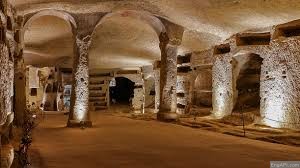

catacombs
音标:
英音/ ˈkætəkuːmz / 美音/ ˈkætəkoʊmz /
听听基本释意:
外刊例句:
The churches share the same holy sites, perhaps the most important being the Monastery of the Caves and its catacombs holding the bodies of saints deeply revered in both Ukraine and Russia.
教堂共享相同的圣地,也许最重要的是洞穴的修道院及其地下墓穴,将圣徒的尸体抱在乌克兰和俄罗斯。
—New York Times
“There is no need to climb into these catacombs and crawl underground through these industrial facilities,” he said, while praising Mr Shoigu for the successful operation to “liberate Mariupol” from Ukraine.
他说:“无需登上这些墓穴,并通过这些工业设施爬到地下爬行。”
—BBC
In contrast, the catacombs take up no existing land.
相比之下,墓穴不占用现有土地。
—The Guardian
基本释意:
none
none
地下墓穴(catacomb 的复数);陵寝
同义词:
没有找到同义词
短释义:
You’re most likely to come across this word in its plural form, catacombs, and it’s almost always used in the context of the ancient Roman empire. A catacomb is shaped like a long tunnel, with space for bodies to be buried, often in tombs. The root word is the Late Latin catacumbae, which refers to one specific catacomb under the Appian Way in ancient Rome, in which the Biblical apostles Peter and Paul are said to be buried.
使用名词迪马布谈论一个旧的地下公墓。最著名的墓穴是由古罗马人建造的。
长释义:
You’re most likely to come across this word in its plural form, catacombs, and it’s almost always used in the context of the ancient Roman empire. A catacomb is shaped like a long tunnel, with space for bodies to be buried, often in tombs. The root word is the Late Latin catacumbae, which refers to one specific catacomb under the Appian Way in ancient Rome, in which the Biblical apostles Peter and Paul are said to be buried.
您最有可能以其复数形式(墓穴)遇到这个词,并且几乎总是在古罗马帝国的背景下使用。墓穴的形状像一条长隧道,通常在坟墓中埋葬身体的空间。词根是拉丁墓穴晚期,它指的是在古罗马的Appian方式下的一个特定的迪马布尔,据说圣经的使徒彼得和保罗被埋葬了。
文学例句:
There was an immense sighing and moaning, like a subterranean bellows breathing in the lost catacombs.
叹息着,an吟着,就像失落的地下墓穴中的地下风龙呼吸一样。
—The Martian Chronicles by Ray Bradbury
The story of their adventure into the catacombs was evident from the dirt encrusted in their clothes and the smiles etched onto their faces.
从衣服上包裹着的污垢以及刻在他们脸上的笑容中可以看出他们冒险进入地下墓穴的故事。
—City Spies by James Ponti
They told of the places they had been, which mostly seemed to be catacombs and plague-pits.
他们讲述了他们去过的地方,这主要是灾难和鼠疫坑。
—The Graveyard Book by Neil Gaiman
词源:
catacomb (n.)”underground burial place,” usually catacombs, from Old English catacumbas, from Late Latin catacumbae (plural) “sepulchral vaults,” originally the region of underground tombs near Rome between the 2nd and 3rd milestones of the Appian Way (where the bodies of apostles Paul and Peter, among others, were said to have been laid); the word is of obscure origin, perhaps once a proper name, or dissimilation from Latin cata tumbas “at the graves,” from cata- “among” + tumbas, accusative plural of tumba “tomb” (see tomb).
If so, the word perhaps was altered by influence of Latin -cumbere “to lie.” From the same source are French catacombe, Italian catacomba, Spanish catacumba. Extended by 1836 in English to any subterranean receptacle of the dead (as in Paris). Related: Catacumbal.Related entries & more
下面是词源的翻译(机器翻译比较难翻,参考着看)
迪阿马布(n。)“地下墓地”,通常来自旧英国塔巴库巴斯的地下墓穴,来自拉丁墓穴后期(复数)“坟墓”,是罗马附近的地下墓地,最初是阿皮亚之路第二和第三个里程碑之间的地下坟墓(据说使徒保罗和彼得等人的尸体被搁置了);这个词是晦涩难懂的起源,也许是一个专有名称,或者与拉丁语cata tumbas的“坟墓”中的cata-“ + tumbas”中的cata-,tumba“ tomb”(见墓)中的cata-”。如果是这样,这个词可能会因拉丁语-cumbere的影响而改变。来自同一来源的是法国墓穴,意大利墓穴,西班牙塔巴库巴。 1836年以英语扩展到死者的任何地下容器(如巴黎)。相关:disacumbal。相关条目及更多
本站没有存储任何书籍、杂志和报纸。
页面内容只做展示和推荐。如果您喜欢本期内容请购买正版。
This site does not store any books, magazines or newspapers.
The contents of the pages are for display and recommendation only.
If you like the content of this issue please purchase the original.